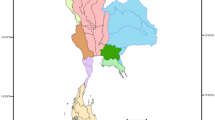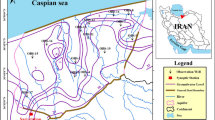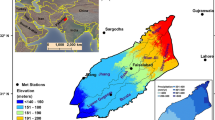Abstract
Groundwater overdraft in many regions throughout the world has been threatening the sustainability of this valuable resource. It has been argued that climate change may contribute to the severity of the issue; hence “impact assessment” is being replaced by “adaptation,” which explores more adapting scenarios and approaches. This study explores the adaptability of the proposed cyclic and non-cyclic conjunctive use of groundwater and surface water resources in increasing groundwater sustainability while increasing the sustainability of water allocation to the agricultural sector under possible climate change scenarios. To simulate climate change in the study area, precipitation and temperature variables are extracted from the results of three global atmospheric circulation models (Ensemble, CMCC-CMS, MRI-CGCM3) under RCP2.6 and RCP8.5 greenhouse gas emission scenarios in the period of 2021–2031. Spatial downscaling is performed using the M5 decision tree algorithm. The Wavelet-M5 hybrid model is used to predict runoff values as a rainfall-runoff model. Also, the Kharrufa method is applied to calculate evaporation in the future seasons. The system's adaptability to climate change is examined using the multi-objective cyclic and non-cyclic conjunctive use of surface and groundwater models. The study reveals that cyclic operation strategy improves the conjunctive use system adaptability compared to the optimal operation strategy that employs the non-cyclic approach. In this study's case study, the improvement in groundwater sustainability index exceeds 27 percent over the non-cyclic conjunctive use strategy.





Similar content being viewed by others
References
Abbasian M, Moghim S, Abrishamchi A (2019) Performance of the general circulation models in simulating temperature and precipitation over Iran. Theor Appl Climatol 135:1465–1483
Afshar A, Khosravi M, Ostadrahimi L, Afshar A (2020) Reliability-based multi-objective optimum design of nonlinear conjunctive use problem; Cyclic Storage System Approach. J Hydrol 588. https://doi.org/10.1016/j.jhydrol.2020.125109
Afshar A, Tavakoli MA, Khodagholi A (2020b) Multi-Objective Hydro-Economic Modeling for Sustainable Groundwater Management. Water Resour Manag 34:1855–1869
Alimohammadi S, Afshar A, Mariño MA (2009) Cyclic storage systems optimization: Semidistributed parameter approach. J / Am Water Work Assoc 101:90–103
Bloomfield JP, Marchant BP, McKenzie AA (2019) Changes in groundwater drought associated with anthropogenic warming. Hydrol Earth Syst Sci 23:1393–1408
Chakraei I, Safavi HR, Dandy GC, Golmohammadi MH (2021) Integrated simulation-optimization framework for water allocation based on sustainability of surface water and groundwater resources. J Water Resour Plan Manag 147(3):05021001
Cuthbert MO, Gleeson T, Moosdorf N et al (2019) Global patterns and dynamics of climate–groundwater interactions. Nat Clim Chang 9:137–141
Dehghanipour AH, Schoups G, Zahabiyoun B, Babazadeh H (2020) Meeting agricultural and environmental water demand in endorheic irrigated river basins: A simulation-optimization approach applied to the Urmia Lake basin in Iran. Agric Water Manag 241: 106353.
Ehteram M, Mousavi SF, Karami H et al (2018) Reservoir operation based on evolutionary algorithms and multi-criteria decision-making under climate change and uncertainty. J Hydroinformatics 20:332–355
Ghamarnia H, Lorestani M (2018) Evaluating the efficiency of temperature empirical based methods for estimating evapotranspiration in different climate conditions (case study of Iran). J Water Irrigation Manag 8(2):303–319 ((In Persian))
Golfam P, Ashofteh P-S, Rajaee T, Chu X (2019) Prioritization of water allocation for adaptation to climate change using multi-criteria decision making (MCDM). Water Resour Manag 33:3401–3416
Gorelick SM (1983) A review of distributed parameter groundwater management modeling methods. Water Resour Res 19:305–319
Goyal MK, Ojha CSP (2012) Downscaling of precipitation on a lake basin: evaluation of rule and decision tree induction algorithms. Hydrol Res 43:215–230
Hamamouche MF, Kuper M, Riaux J, Leduc C (2017) Conjunctive use of surface and ground water resources in a community-managed irrigation system—The case of the Sidi Okba palm grove in the Algerian Sahara. Agric Water Manag 193:116–130
Hashemi H, Berndtsson R, Persson M (2015) Artificial recharge by floodwater spreading estimated by water balances and groundwater modelling in arid Iran. Hydrol Sci J 60:336–350
Her Y, Yoo S, Seong C et al (2016) Comparison of uncertainty in multi-parameter and multi-model ensemble hydrologic analysis of climate change. Sci Total Environ 1–44
Jahanpour M, Afshar A, Solis SS (2015) An object-oriented development environment to optimally design cyclic storage systems. J Hydroinformatics. https://doi.org/10.2166/hydro.2015.049
Jha MK, Peralta RC, Sahoo S (2020) Simulation-optimization for conjunctive water resources management and optimal crop planning in kushabhadra-bhargavi river delta of eastern India. Int J Environ Res Public Health 17:3521
Joodavi A, Izady A, Maroof MTK et al (2020) Deriving optimal operational policies for off-stream man-made reservoir considering conjunctive use of surface-and groundwater at the Bar dam reservoir (Iran). J Hydrol Reg Stud 31:100725
Kerebih MS, Keshari AK (2021) Distributed simulation-optimization model for conjunctive use of groundwater and surface water under environmental and sustainability restrictions. Water Resour Manag. https://doi.org/10.1007/s11269-021-02788-5
Kharrufa NS (1985) Simplified equation for evapotranspiration in arid regions. Beiträge Zur Hydrol 5:39–47
Khosravi M, Afshar A, Molajou A (2020) Reliability-Based Design of Conjunctive Use Water Resources Systems: Comparison of Cyclic and Non-Cyclic Approaches. J Water Wastewater 7:90–101. https://doi.org/10.22093/wwj.2020.201234.2924 (In persian)
Kolokytha E, Malamataris D (2020) Integrated Water Management Approach for Adaptation to Climate Change in Highly Water Stressed Basins. Water Resour Manag 34(3):1173–1197
MacEwan D, Cayar M, Taghavi A et al (2017) Hydroeconomic modeling of sustainable groundwater management. Water Resour Res 53:2384–2403
Medellín-Azuara J, MacEwan D, Howitt RE et al (2015) Hydro-economic analysis of groundwater pumping for irrigated agriculture in California’s Central Valley, USA. Hydrogeol J 23:1205–1216
Miro ME, Famiglietti JS (2019) A framework for quantifying sustainable yield under California’s Sustainable Groundwater Management Act (SGMA). Sustain Water Resour Manag 5:1165–1177
Molajou A, Afshar A, Khosravi M et al (2021a) A new paradigm of water, food, and energy nexus. Environ Sci and Pollut Res. https://doi.org/10.1007/s11356-021-13034-1
Molajou A, Nourani V, Afshar A et al (2021b) Optimal Design and Feature Selection by Genetic Algorithm for Emotional Artificial Neural Network (EANN) in Rainfall-Runoff Modeling. Water Resour Manag. https://doi.org/10.1007/s11269-021-02818-2
Nayak MA, Herman JD, Steinschneider S (2018) Balancing flood risk and water supply in california: policy search integrating short-term forecast ensembles with conjunctive use. Water Resour Res 54:7557–7576
Nourani V, Davanlou Tajbakhsh A, Molajou A, Gokcekus H (2019a) Hybrid wavelet-M5 model tree for rainfall-runoff modeling. J Hydrol Eng 24:4019012
Nourani V, Razzaghzadeh Z, Baghanam AH, Molajou A (2019b) ANN-based statistical downscaling of climatic parameters using decision tree predictor screening method. Theor Appl Climatol 137:1729–1746
Nourani V, Tajbakhsh AD, Molajou A (2019c) Data mining based on wavelet and decision tree for rainfall-runoff simulation. Hydrol Res 50:75–84
Nourani V, Rouzegari N, Molajou A (2020) An Integrated Simulation-Optimization Framework to Optimize the Reservoir Operation Adapted to Climate Change Scenarios. J Hydrol. https://doi.org/10.1016/j.jhydrol.2020.125018
Park C-H, Aral MM (2004) Multi-objective optimization of pumping rates and well placement in coastal aquifers. J Hydrol 290:80–99
Rahmati O, Golkarian A, Biggs T et al (2019) Land subsidence hazard modeling: Machine learning to identify predictors and the role of human activities. J Environ Manage 236:466–480
Sandoval-Solis S, McKinney DC, Loucks DP (2011) Sustainability index for water resources planning and management. J Water Resour Plan Manag 137:381–390
Sayed E, Riad P, Elbeih SF et al (2020) Sustainable groundwater management in arid regions considering climate change impacts in Moghra region, Egypt. Groundw Sustain Dev. https://doi.org/10.1016/j.gsd.2020.100385
Seo SB, Mahinthakumar G, Sankarasubramanian A et al (2018) Conjunctive management of surface water and groundwater resources under drought conditions using a fully coupled hydrological model. J Water Resour Plan Manag 144:04018060
Shah T (2009) Climate change and groundwater: India’s opportunities for mitigation and adaptation. Environ Res Lett 4:35005
Song J, Yang Y, Sun X et al (2020) Basin-scale multi-objective simulation-optimization modeling for conjunctive use of surface water and groundwater in northwest China. Hydrol Earth Syst Sci 24:2323–2341
Taormina R, Chau KW, Sethi R (2012) Artificial neural network simulation of hourly groundwater levels in a coastal aquifer system of the Venice lagoon. Eng Appl Artif Intell 25:1670–1676
Tegegne G, Kim Y, Lee J (2019) Spatiotemporal reliability ensemble averaging of multi-model simulations. Sci Total Environ 704:12–29
Acknowledgements
Authors appreciate Iran National Science Foundation (INSF) for their partial support through grant number 96010175.
Funding
This work was supported by Iran National Science Foundation (INSF), grant number:96010175.
Author information
Authors and Affiliations
Contributions
Abbas Afshar: Conceptualization, Methodology, Writing—original draft, Supervision, Funding acquisition. Mina Khosravi: Conceptualization, Methodology, Writing—original draft, Software. Amir molajou: Conceptualization, Methodology, Software.
Corresponding author
Ethics declarations
Consent for Publication
The authors give their full consent for the publication of this manuscript.
Conflicts of Interest
There is no conflict of interest.
Additional information
Publisher's Note
Springer Nature remains neutral with regard to jurisdictional claims in published maps and institutional affiliations.
Rights and permissions
About this article
Cite this article
Afshar, A., Khosravi, M. & Molajou, A. Assessing Adaptability of Cyclic and Non-Cyclic Approach to Conjunctive use of Groundwater and Surface water for Sustainable Management Plans under Climate Change. Water Resour Manage 35, 3463–3479 (2021). https://doi.org/10.1007/s11269-021-02887-3
Received:
Accepted:
Published:
Issue Date:
DOI: https://doi.org/10.1007/s11269-021-02887-3




